The healthiest fruits for kids and adults

The benefits of fruits cannot be overestimated. They have not only a pleasant rich taste, but also a natural origin, due to which they are considered the best substitute for sweets and dishes prepared with the addition of artificial ingredients (sweeteners, preservatives, flavorings). Vegetables and fruits are foodstuffs that have been used by humans for a long time to fill the feeling of hunger, they contain the optimal set of ingredients necessary to ensure life and maintain health at a satisfactory level.
The constant use of plant products allows you to avoid most common diseases, including such dangerous ones as cancer. Almost all fruits are mainly composed of fiber, which contributes to comfortable digestion. In addition, vitamins, minerals and other trace elements occupy a large proportion in their composition, without which no living organism can exist.A small amount of calories contributes to the fact that fruits and their derivatives form the basis of diet programs, as well as menus for children of all ages.
Despite all the positive properties, do not forget about the measure, since exceeding the recommended dose can cause indigestion, complications of the diabetic profile, the occurrence of allergic manifestations on the skin and damage to the protective layer on the teeth (enamel erosion). You can consume more than the recommended amount only after consulting a specialist (doctor).
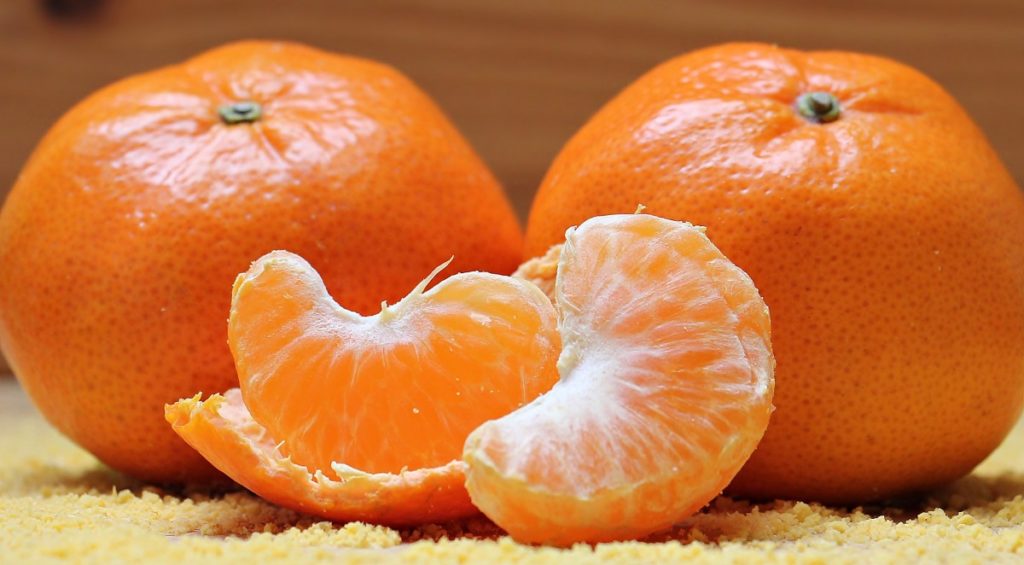
Content [Hide]
Trace elements and other useful substances contained in plant foods
- Cellulose. The main component of plant products. It consists of fibers that, when passing through the digestive tract, sanitize it and remove unprocessed food residues, helping to remove toxins and cleansing the body of unnecessary ballast. For constipation, it is recommended to consume foods containing fiber daily, mainly in the evening, in order to facilitate the defecation process in the morning.
- Fructose. This is the so-called "natural sugar". Its main benefit is that it does not increase blood sugar levels, as occurs with the use of artificial substitutes. This is especially important for diabetics, however, it will not be superfluous for healthy people to replace crystalline sugar with fructose.Due to its low calorie content, it promotes weight loss, and at the same time makes it possible to compensate for the lack of energy.
- Acid. Another element that has a positive effect on the human body. Depending on the type of plant, the type of acid varies, but most of them have common properties: they help restore cell metabolism, stimulate regeneration and give cells elasticity, due to saturation with components such as collagen and elastane. In addition, acids reduce moisture loss, which slows down aging and improves the appearance of the skin.
- Protein. It is the main "building component" for cells, which ensures the regeneration and restoration of damaged elements of the epidermis. It is an indispensable element in the production of certain hormones, without which the proper functioning of the bone and muscle system is impossible.
- Vitamins. Almost all of their species are found in plant foods. Basic: A, group B, C, K, PP. Without them, the development and normal functioning of any system in the body is impossible.
- Minerals. Most often, potassium, magnesium, phosphorus, manganese and iron are found in fruits.
How to eat fruits
Many people wonder what the minimum amount of plant foods should be in a healthy person's diet. There are several medical theories on this subject, but most of them agree that the total amount of fruit in the daily diet of a person of average build and normal level of physical activity should be about 300 grams. At the same time, people with a large body weight and leading an active lifestyle can consume up to 500 grams daily.When following a diet, it is recommended to pay attention to the calorie content of food, and one serving should contain no more than 60 kcal. On average, this is one medium-sized fruit, or a handful of small berries (grapes, strawberries, etc.). During the day, you can consume up to 2 such servings.
Depending on the content of fructose in a particular fruit, the time of its optimal use varies: if there is a lot of sugar, it is better to eat the product no later than a few hours before bedtime, provided that active pastime is expected after eating (this is important in order not to increase blood glucose).
It is not recommended to eat fruits at night, which increase the rate of production of gastric juice and increase appetite, especially if you do not plan to eat after that. In this case, the "excess" gastric juice can irritate the surrounding tissues, leading to gastritis and other digestive problems.
If the use of fruits is tied to the time of the main meal, then it is best to eat them 30 minutes before, or 1 hour after. In this case, they will be absorbed faster and give the most useful substances. It is best to eat fruits before meals, and in this case they directly enter the large intestine, where they are broken down and more fully absorbed. In this case, the likelihood of such unpleasant effects as bloating and gas formation is reduced.
It is best to buy fresh fruits and eat them whole, without cutting or rubbing. In this case, the maximum number of trace elements is preserved, many of which are destroyed during mechanical and heat treatment.In the event that it is not possible to buy fresh products, or they are prohibited for medical reasons, you should not refuse to use them at all, as an alternative, you can eat frozen or cooked fruits.
Rating of the healthiest fruits
Pomegranate
votes 1
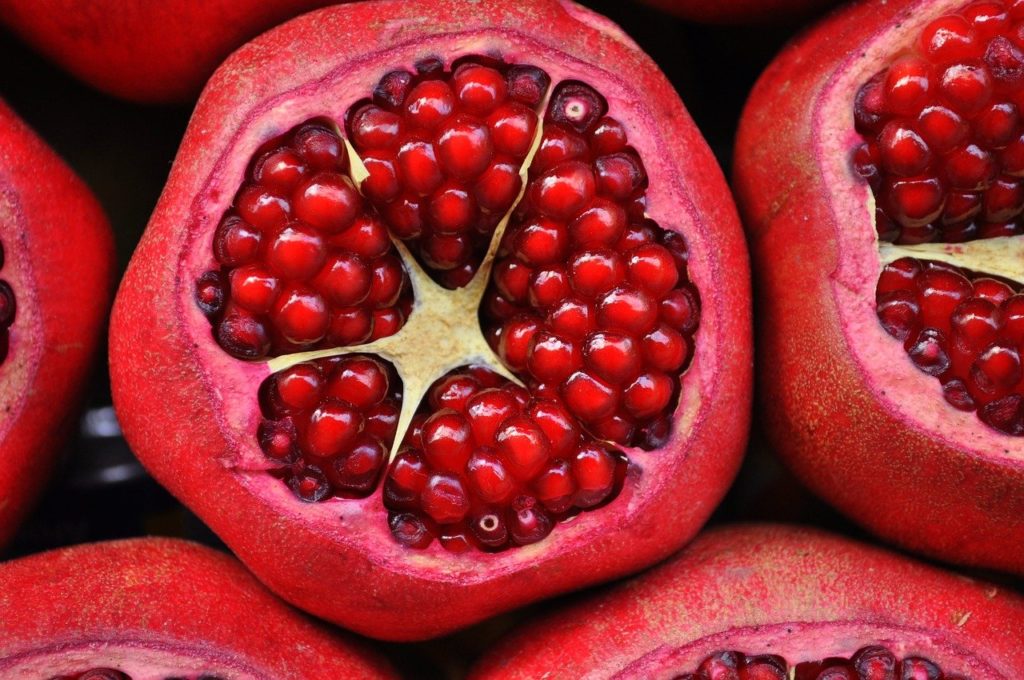
The fruit grows on trees 6-8 meters high, which are considered long-lived among plants - some of them reach the age of 120-130 years. A large number of varieties and varieties have been bred by man, which differ from each other in color, shape, taste. The tree grows in warm regions and does not like cold climates.
The pomegranate is round and deep red in color. The skin covers the seeds, which are surrounded by a pulp with a sweet and sour taste. Scientists have found that the useful volume of the fruit that can be eaten does not exceed 50% of the total weight, which is associated with a large number of seeds and a thick peel. For the most part, pomegranate consists of water (about 64%), the rest is proteins and carbohydrates, and the latter are more. Carbohydrates are mainly represented by fructose. The energy value of the product is 62 kcal.
Pomegranate is rich in vitamins, minerals, and other useful trace elements. Vitamins - C, B6, B12, PP.
The first plays a key role in immunity and is the main prescription of doctors for colds. The next two are necessary for the normal functioning of the nervous system and the formation of red cells in the circulatory system. In addition, pomegranate contains a large amount of acids, including oxalic, malic, citric, boric and others. It contains folic acid, which is recommended for women during pregnancy for the proper formation of the neural tube in the unborn child.The pomegranate also contains minerals: calcium, potassium, manganese, iron, tannins. In addition, pomegranate contains pectins, which have a cleansing property and remove toxins, radionuclides and other elements from the body that can cause various diseases.
Daily use of pomegranate in small amounts is indicated for people with cardiovascular diseases, diseases of the hematopoietic system and those who have problems with the thyroid gland. Pomegranate is useful not only when eating pulp, its peel contains many useful trace elements, including phenols and antioxidants. In order to extract their benefits, the peel is dried and ground into a powder, or extracted.
- can be used to remove toxins, lower blood cholesterol levels;
- has an antioxidant effect;
- Suitable for preparing many dishes.
- should not be consumed in large quantities - due to the high content of acid, pomegranate juice damages the enamel of the teeth, which leads to their destruction;
- lowers blood pressure, which is why it is not recommended for hypotensive patients.
Apples
votes 1
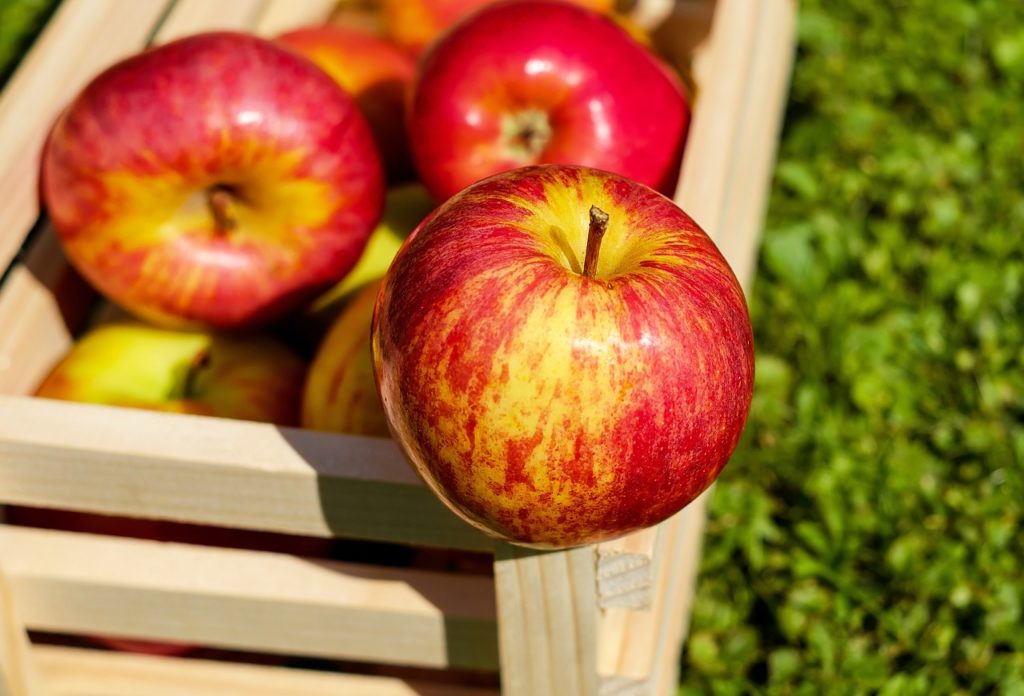
They grow everywhere in the temperate climate zone and have been eaten since ancient times, thanks to which the body of the Slavs has adapted and does not produce allergic reactions when eaten. Due to the wide distribution of apple trees, the cost of fruits is low, and even a person who does not have extra money can afford to buy a kilogram - another. Each apple contains a lot of vitamin C, as well as fiber and polyphenols (prevent cancer).Scientists have found that most of the nutrients are found in the apple peel, so those who cut it off deprive themselves of a portion of vitamins and minerals, as well as other components.
Apples are useful for diseases such as Alzheimer's and bronchial asthma - they reduce the intensity of the appearance of new attacks, and also facilitate the course of the disease. Among other trace elements, apples contain B vitamins, which have a beneficial effect on the state of the nervous system. Other elements contained in apples exclude the degeneration of tissue cells into malignant tumors. 100 grams of the product contains about 85 grams. water, and 14 carbohydrates. The average calorie content does not exceed 52 kcal.
Doctors recommend eating apples daily to prevent a large number of diseases, including stroke, iron deficiency anemia, diabetes, oncology and others. At the same time, there is no need to calculate how many apples you can eat at one meal - if there is no allergy, the amount of food consumed is not limited.
- can be given to children from an early age - starting from 6 months;
- practically has no contraindications;
- has a positive effect on most organs and systems of the body;
- used in cosmetology (skin care), as well as in cooking (cooking a variety of dishes).
- many buyers underestimate the benefits of apples, considering them "empty" fruits.
You can read about the best apple juice here.
Kiwi
votes 1
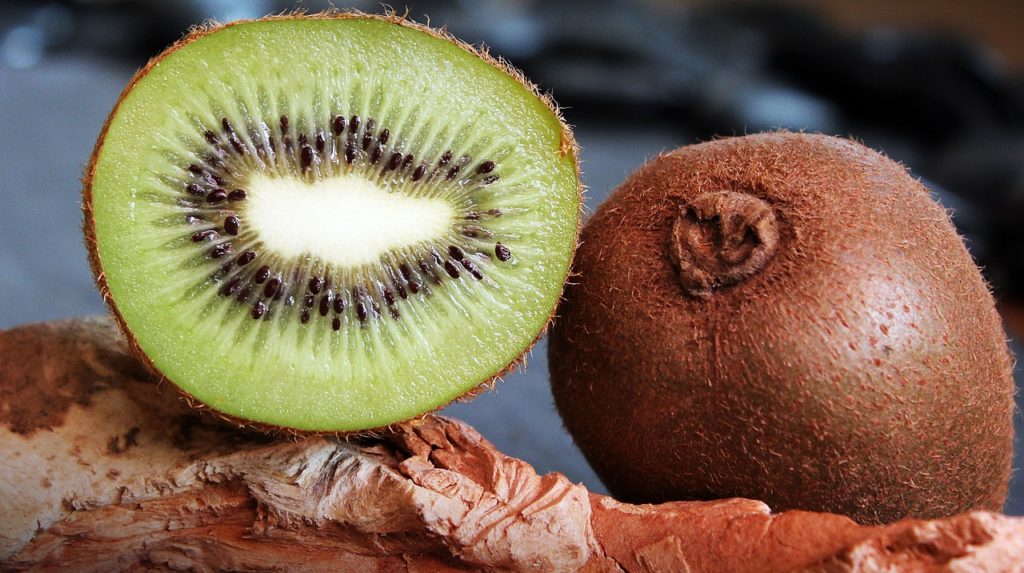
Not many people know where and how this fruit grows. Most believe that this is the fruit of a tree, although in fact, kiwi grows on a tree-like vine, which is most often found in Southeast Asia. Kiwi is also called Chinese gooseberry.Most fruits are round in shape, but there are also heart-shaped varieties. More than 50% of kiwis are grown in China. Kiwi contains 61 kcal, which is comparable to 3% of the daily diet of a person of average build.
The main part of kiwi is water, the rest is carbohydrates and trace elements. In addition to vitamins and minerals, fruits also contain omega-3 and omega-6 acids.
Due to the presence of antioxidants, the constant use of the product in food can reduce the risk of cancer. In terms of vitamin C content, kiwi is superior to citrus fruits (in particular, orange). Its constant use in food helps to eliminate the deficiency of the necessary elements for the formation of new cells in tissues. The presence of ascorbic acid increases the production of collagen, which stimulates regeneration at the cellular level and slows down the aging process of the epidermis.
Among those who consume kiwi, there is a speedy recovery from respiratory diseases, as well as a decrease in the frequency of asthma attacks. Lutein, contained in the pulp of kiwi, helps to restore and maintain vision, protecting the retina from the harmful effects of ultraviolet radiation. One fruit a day promotes blood thinning and prevents the likelihood of blood clots, which is especially dangerous in a pandemic coronavirus.
- helps with constipation;
- contains many useful trace elements;
- contributes to the prevention of cancer;
- contains more vitamin C than citrus fruits.
- high cost (due to the fact that the fruits do not grow in a temperate climate).
Orange
votes 0
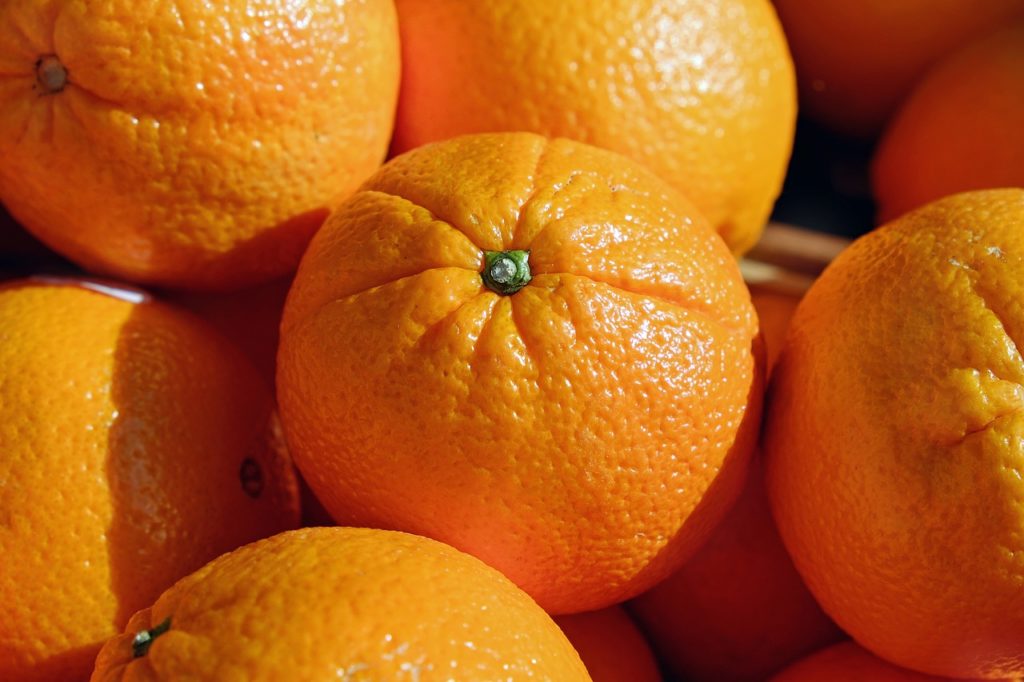
Many people believe that an orange is the record holder for vitamin C, but this is not true.The amount of this nutrient does not exceed the average value in other citrus fruits. Some think that it may also promote weight loss due to the fact that it "burns" fat. The calorie content of the product is 47 kcal.
The main vitamins found in oranges are C, E, B1, B3, B4. The composition also contains minerals: potassium, calcium, iron, magnesium.
Doctors note that orange has a mild laxative effect, improves intestinal motility, and also promotes the outflow of excess fluid during edema. According to ongoing research, people who constantly consume oranges improve vascular permeability, their walls become less fragile. Juices and fruit pulp have antioxidant properties, thereby slowing down the aging process at the cellular level. This happens due to the saturation of cells with oxygen. This ability is in demand among professional athletes, as during intense training, tissues can experience muscle starvation.
An infusion of orange peel is often prescribed for diabetes mellitus, as it prevents the formation of necrosis on the skin and internal tissues. The pulp is also useful for those people who do not control their diet and often eat fatty foods - oranges neutralize micro-inflammations in the vessels that appear due to an increase in fat peroxidation. In addition, juices and pulp can lower blood pressure, and are recommended for hypertensive patients on an ongoing basis.
According to scientists, an alcohol infusion of orange peel has a bactericidal effect against a common bacterium - helicobacter pylori. It also contributes to the normalization of the intestinal microflora and is indicated for various forms of dysbacteriosis.
- useful in the treatment of many diseases;
- low calorie;
- low cost, despite the fact that orange trees do not grow in the temperate zone.
- most oranges have a sour taste that many children and adults do not like;
- strong allergen;
- contraindicated in diarrhea.
A pineapple
votes 0
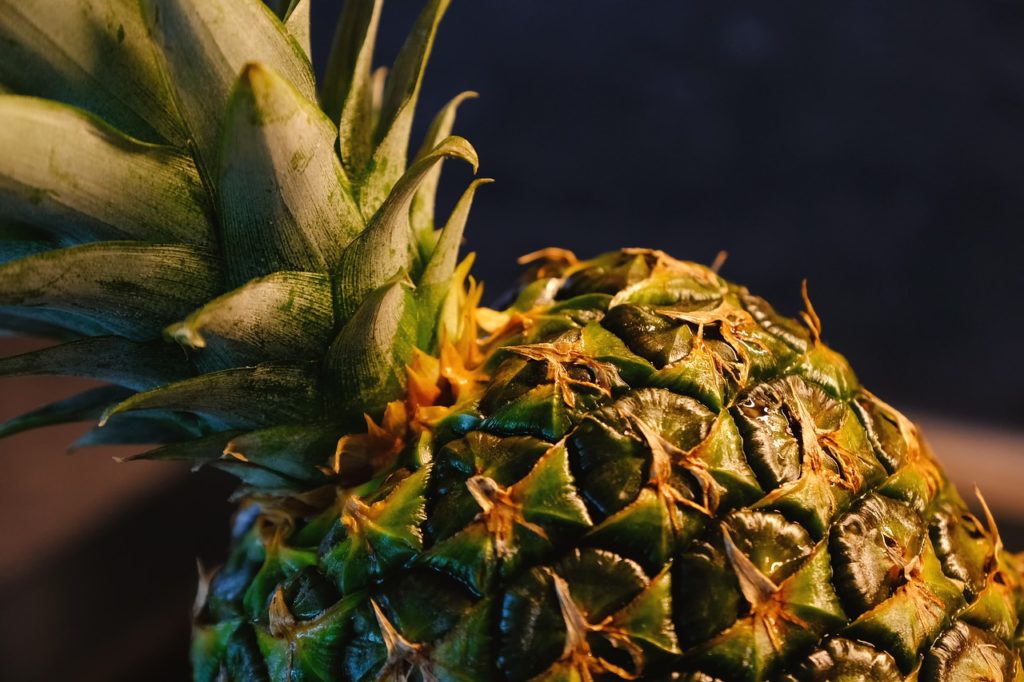
Pineapple is distinguished not only by its beautiful appearance, but also by its universal application: it is used to prepare a large number of dishes in cooking (from desserts to soups), medicine (treatment of diseases of the respiratory and cardiovascular systems), industry (manufacture of leatherette, textile fiber, plastic), etc. According to the studies of some scientists, the substances contained in pineapple can prevent the occurrence of various oncological diseases.
The calorie content of pineapple is 50 kcal. Fruits are recommended to be consumed fresh, since after conservation, fiber is destroyed and the glucose content increases, which imposes restrictions on the amount of product consumed.
One of the main beneficial nutrients of pineapple is bromelain, the main concentration of which is concentrated in the core. It promotes the breakdown of fat, so it is included in the list of products that are recommended for weight loss. The same microelement has a diuretic effect (it helps to reduce swelling), and also helps to get rid of constipation.
The largest share in the composition of pineapple is occupied by vitamin C (responsible for maintaining immunity), after which group B holds the leading position (B3-B6, contribute to the normalization of the nervous system), as well as nicotinic acid (improves the functioning of the pancreas).Trace elements contained in pineapple regulate the water-salt balance in the body, help strengthen the musculoskeletal skeleton, and improve mental activity.
You can read about the best pineapple juice here.
- helps with weight loss;
- lowers blood pressure;
- used in the preparation of a large number of dishes.
- high price;
- may cause cracked lips in some people;
- Ripe fruits quickly deteriorate during transportation, so many sellers bring green pineapples for sale, which are inferior in quality to those that have come down to condition.
Bananas
votes 1
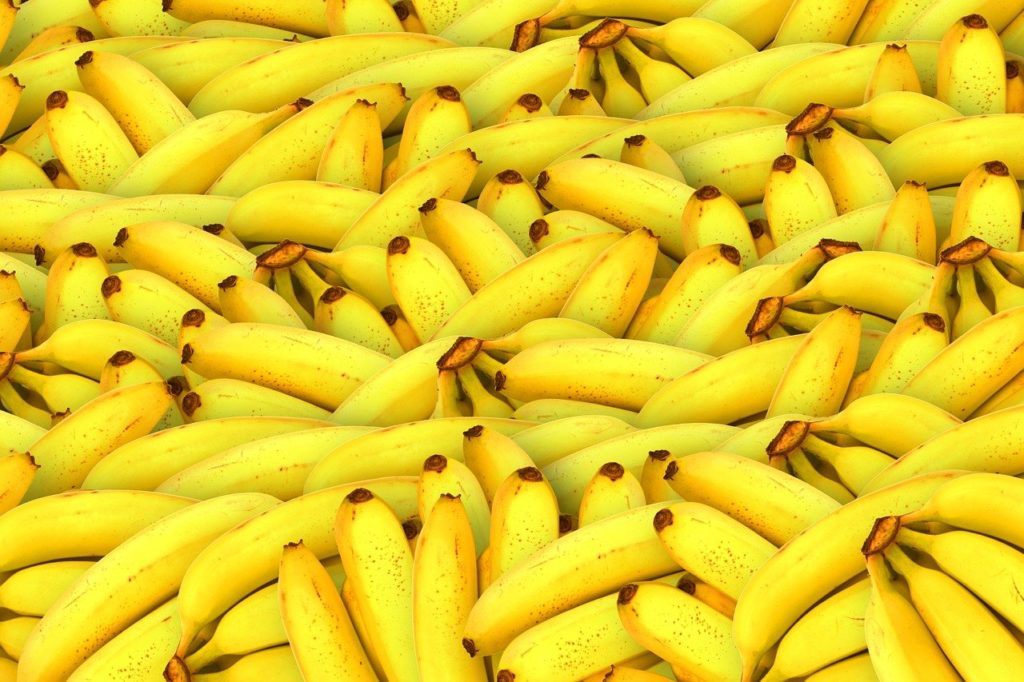
Despite the fact that many people call a banana a fruit, by botanical origin it belongs to the berries. People have been eating them for over 10,000 years, thanks to which humanity has developed such a strong addiction to them that it does not cause allergies even in children of the first year of life. During this time, the taste and composition of the berries have undergone significant changes: the number of seeds has decreased, and the taste has also increased).
All bananas are divided into two categories: vegetable and dessert. The first is the most common, and the second is distinguished by high palatability, the skin of these fruits can be of various colors (red, green, brown, etc.).
The main benefit of eating bananas is the cardiovascular system - due to the high content of potassium, the heart muscle works more efficiently and the blood pressure level approaches the optimum.
They also contain substances that prevent the absorption of cholesterol from other foods, thereby reducing the formation of atherosclerotic plaques.Due to the high fiber content, daily consumption of bananas improves intestinal motility and normalizes its work with constipation.
In addition, bananas are recommended for people with diabetes - they have a sweet taste, and at the same time a low glycemic index. The same property makes the fruit indispensable for the nutrition of athletes. The calorie content of the product is 96 kcal per 100 grams.
- helps to improve the work of the cardiovascular system;
- does not cause allergies;
- suitable for feeding young children.
- high calorie content does not allow eating bananas during the diet;
- when stored together with other fruits, they accelerate their ripening, and, accordingly, spoilage.
Persimmon
votes 0
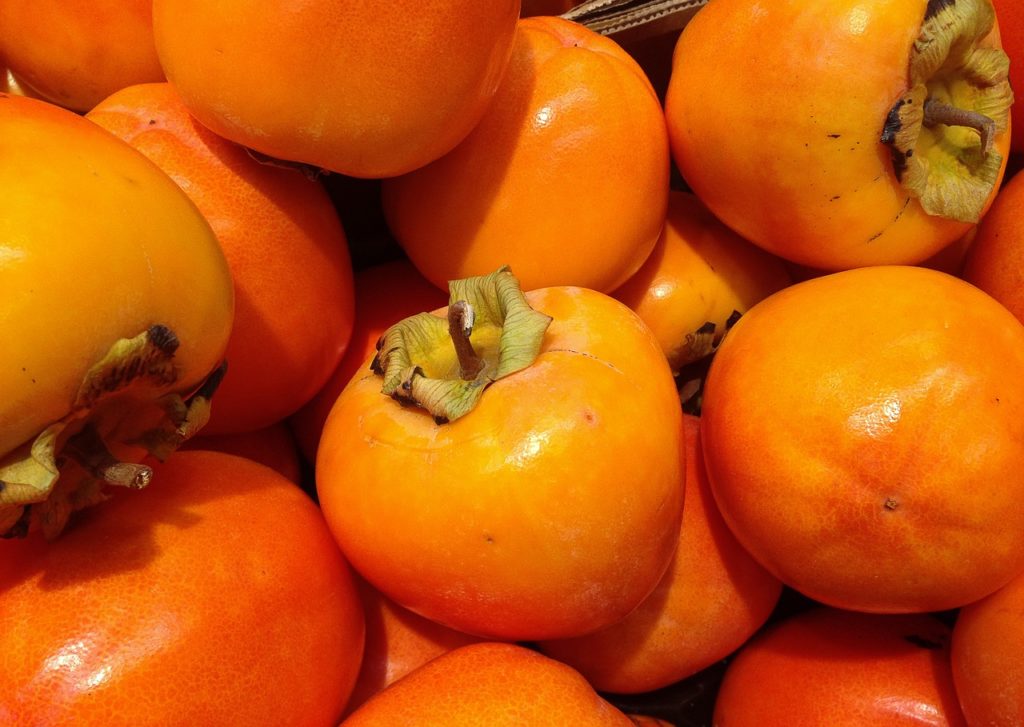
The birthplace of persimmon is China, in addition, it grows in other countries with a warm climate: India, Turkey, Spain, Abkhazia. Despite the fact that most people call persimmon a fruit, in fact it grows on shrubs that can be up to 500 years old, and belongs to the berries. The product is consumed fresh, frozen and dried. In the latter case, it is called dried apricots. The calorie content of persimmon is low - 66 kcal, however, the glycemic index exceeds the average values for other vegetable fruits and is 50 units.
The main components of persimmon are ascorbic and pantothenic acids, beta-carotene, biotin.
Pectin, which is part of the product, normalizes the intestinal microflora and has a fixing effect. A high iron content will help improve the condition with iron deficiency anemia. The trace elements contained in the pulp of the product have a positive effect on the cardiovascular system (normalizes the rhythm), stabilize the nervous system (due to a calming effect), and also increase appetite.Doctors note that the constant use of persimmon gives the skin elasticity and firmness, slows down the aging process (which is achieved due to the effects of provitamin A on epithelial cells). In addition, the presence of beta-carotene in persimmon helps to reduce the risk of lung cancer, which is high in smokers.
Among other things, persimmon contains iodine, which is recommended for people who have problems with the thyroid gland, as well as those living in areas that have been exposed to radioactive contamination.
- pleasant taste and aroma;
- favorably affects many systems in the human body;
- promotes skin rejuvenation.
- the fruit is seasonal, and is most often found on sale in the autumn-winter period;
- may cause allergies in some people.
Lemon
votes 1
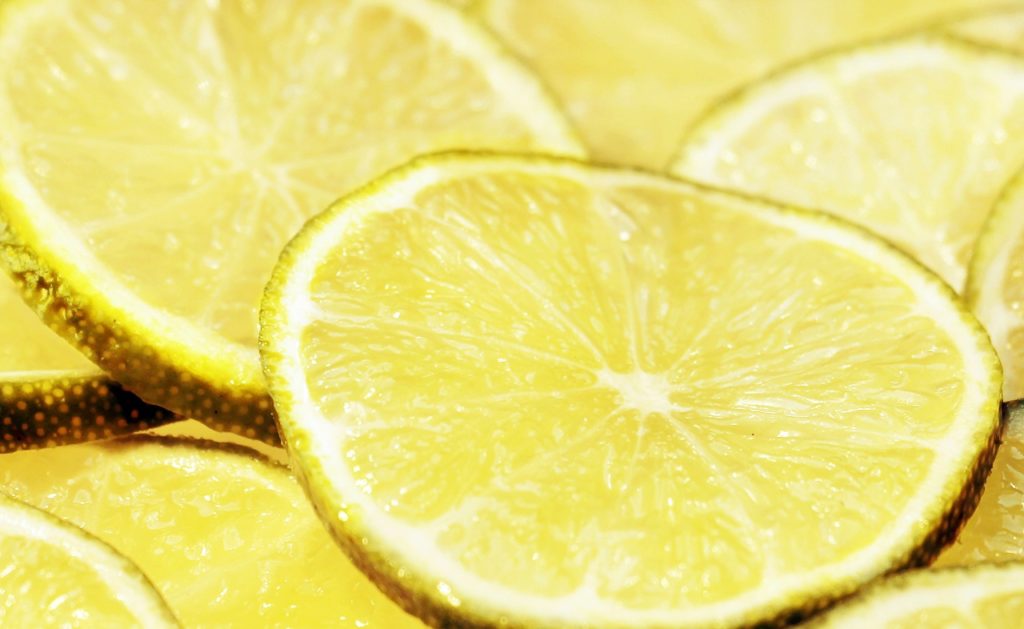
The fruits of a citrus plant have been known for many hundreds of years, and, thanks to their healing properties, they are used not only in cooking, but also in medicine, cosmetology, and other areas of life. It is believed that the content of vitamin C lemon is superior to all other fruits, but this is not true. According to this parameter, it is on a par with other citrus fruits, and even inferior to some of them.
There are 16 kcal per 100 grams of the product, so you can use fresh lemon without restrictions (provided there is no allergy). Since the acidity of the fruit is high, not many people like it, and most often small children with specific taste preferences become “fans” of lemon. Lemon and its components are widely used in cooking - most often it is added to pastries, used for stewing or baking meat and fish, and lemonade is made from the peel.
According to scientists, water with the addition of lemon juice is the best drink to eliminate thirst in the hot season.
In medicine, lemon extract is used to reduce blood cholesterol, lower blood pressure, improve the functioning of the renal system (especially in the presence of urolithiasis). In addition to the fact that lemon saturates the body with useful microelements, it helps to eliminate constipation, increase the acidity of the stomach with gastritis, and alleviate the symptoms of cholecystitis and gout. The main thing that lemon helps with is the first symptoms of a cold, because due to the high content of vitamin C, the work of human immunity is stimulated.
Lemon is also used by housewives in household chores. Adding a few drops of its juice to baking soda will make a natural cleanser, and applying the extract diluted with water to your hair will lighten it by several tones.
- improves immunity;
- wide application not only in medicine, but also in cooking, household;
- long shelf life.
- sour taste that not many people like;
- strong allergen.
Mango
votes 0
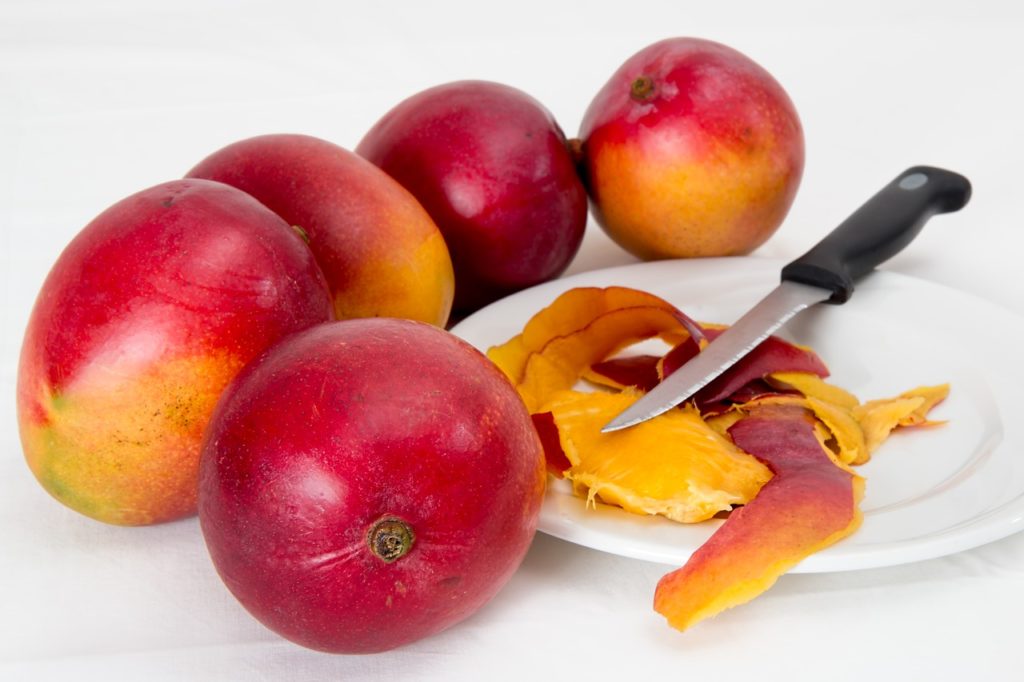
The exotic fruit is little known in Russia, but is widely distributed in Southeast Asia. Many varieties have been bred by breeders, but most of them have a similar appearance and taste. The average weight of the product is 500 grams, but large specimens up to 1.5 kilograms can be found on sale. The mango growing season is limited to a few months - from April to May. During this period, the fruits are the most delicious and fresh, and those grown at other times - for the most part, contain artificial additives.
The calorie content of mango per 100 grams is 60 kcal. The main vitamins are C, B3-5, E.About 15% of the specific weight is occupied by carbohydrates (fructose). Fiber is present in large quantities. There are also minerals - calcium, potassium, phosphorus, iron, magnesium. The product also contains essential amino acids (12 items).
The rich composition contributes to the beneficial effects of constant consumption of mango on human health - it helps to reduce body temperature, tones up, improves the functioning of the cardiovascular system, and facilitates the course of diseases such as stomatitis and other inflammatory reactions in the oral cavity. Doctors note the positive effect of mango on the course of diabetes, including it can help get rid of excess weight and reduce the content of bad cholesterol in the blood.
Before buying a mango, it is recommended to find out who should not eat it. First of all, these are people who are prone to allergic reactions (at the same time, most often such reactions occur when eating the peel - mango pulp is hypoallergenic). With caution, the fruit should be given to young children, and adults should not drink alcohol within 2 hours after they have tasted the mango.
- pleasant sweet taste;
- many useful features.
- high price;
- most of the mangoes sold in Russian supermarkets have nothing to do with the juicy fruits that grow in their homeland.
Pear
votes 0
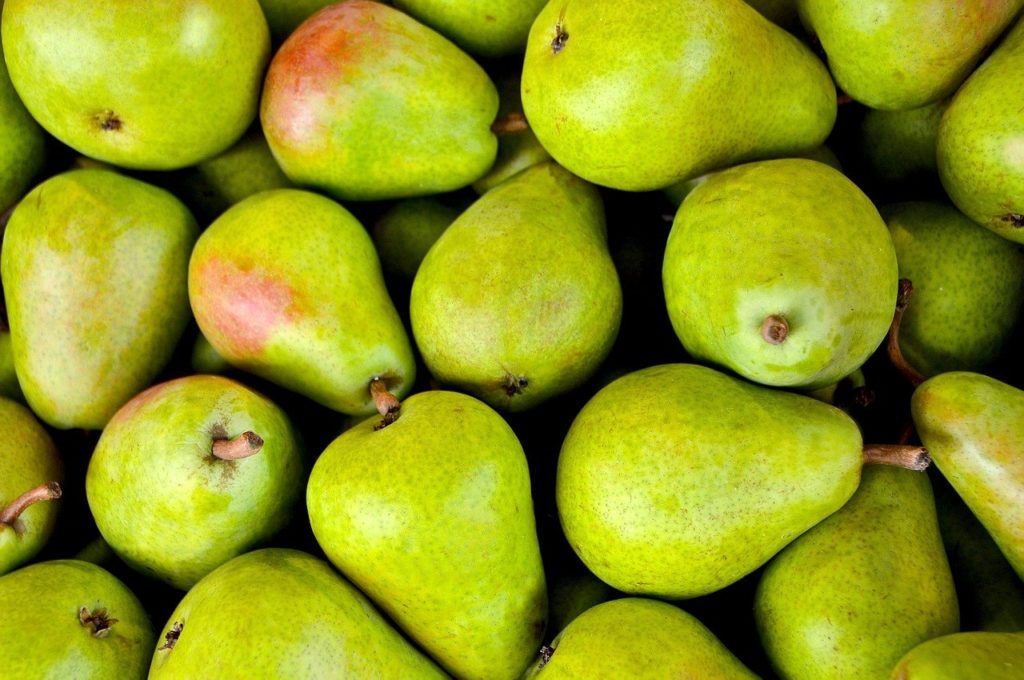
In Chinese culture, it is considered a symbol of immortality. This is due to the rich composition and a large number of useful properties. The calorie content of 100 grams of the product is on average 47 kcal, which allows you to use it in unlimited quantities if you are overweight. The main vitamins that make up the pear are C, K, B9.The latter - folic acid - is useful for pregnant women, especially in the early stages, as it contributes to the proper development of the neural tube of the unborn baby.
In addition, the pear contains a large amount of other nutrients, including phytosterols and purines, boron, iron, cobalt, silicon. A large proportion is occupied by lead, which in 100 grams of the product can be more than the average daily intake of a person per day.
Daily consumption of pears helps to strengthen the immune system, helps improve digestion, improves mood, and normalizes the functioning of the kidneys and liver.
When buying pears, it should be borne in mind that if a tree grows in ecologically unfavorable areas, the body may be harmed more than the intended benefit. The most useful varieties are Duchess and Conference. Not inferior to them, but in many ways superior - an ordinary game that grows in forests and abandoned summer cottages.
- does not cause allergies;
- low calorie;
- useful during pregnancy;
- low cost.
- Some fruits are high in lead, which can have a negative impact on health.
Conclusion
Eating fruits is a good habit that should be taught from childhood. Doctors recommend eating at least one fruit a day in order to not have digestive problems, feel good, and not lack vitamins or minerals.In order to eat properly, before choosing a fruit, you need to carefully examine it from all sides, smell it (checking for freshness), and also make sure that there are no dents or other skin defects on it, which may indicate improper cultivation. .
We hope that our review will help you make the right choice!
new entries
Categories
Useful
Popular Articles
-

Top ranking of the best and cheapest scooters up to 50cc in 2025
Views: 131650 -

Rating of the best soundproofing materials for an apartment in 2025
Views: 127689 -

Rating of cheap analogues of expensive medicines for flu and colds for 2025
Views: 124518 -

The best men's sneakers in 2025
Views: 124031 -

The Best Complex Vitamins in 2025
Views: 121938 -

Top ranking of the best smartwatches 2025 - price-quality ratio
Views: 114979 -

The best paint for gray hair - top rating 2025
Views: 113394 -

Ranking of the best wood paints for interior work in 2025
Views: 110318 -

Rating of the best spinning reels in 2025
Views: 105328 -

Ranking of the best sex dolls for men for 2025
Views: 104365 -

Ranking of the best action cameras from China in 2025
Views: 102215 -

The most effective calcium preparations for adults and children in 2025
Views: 102011









